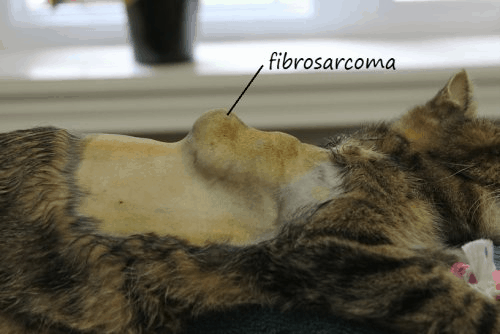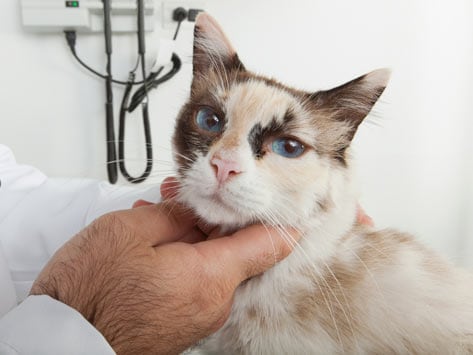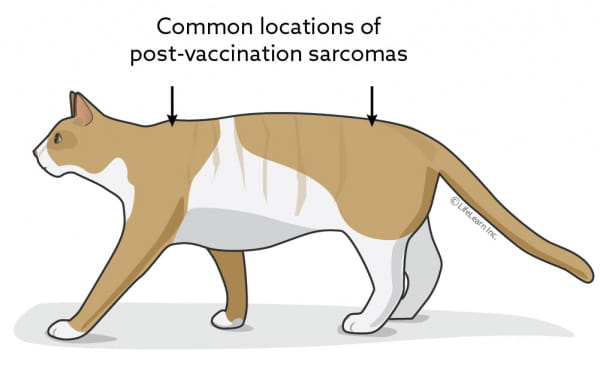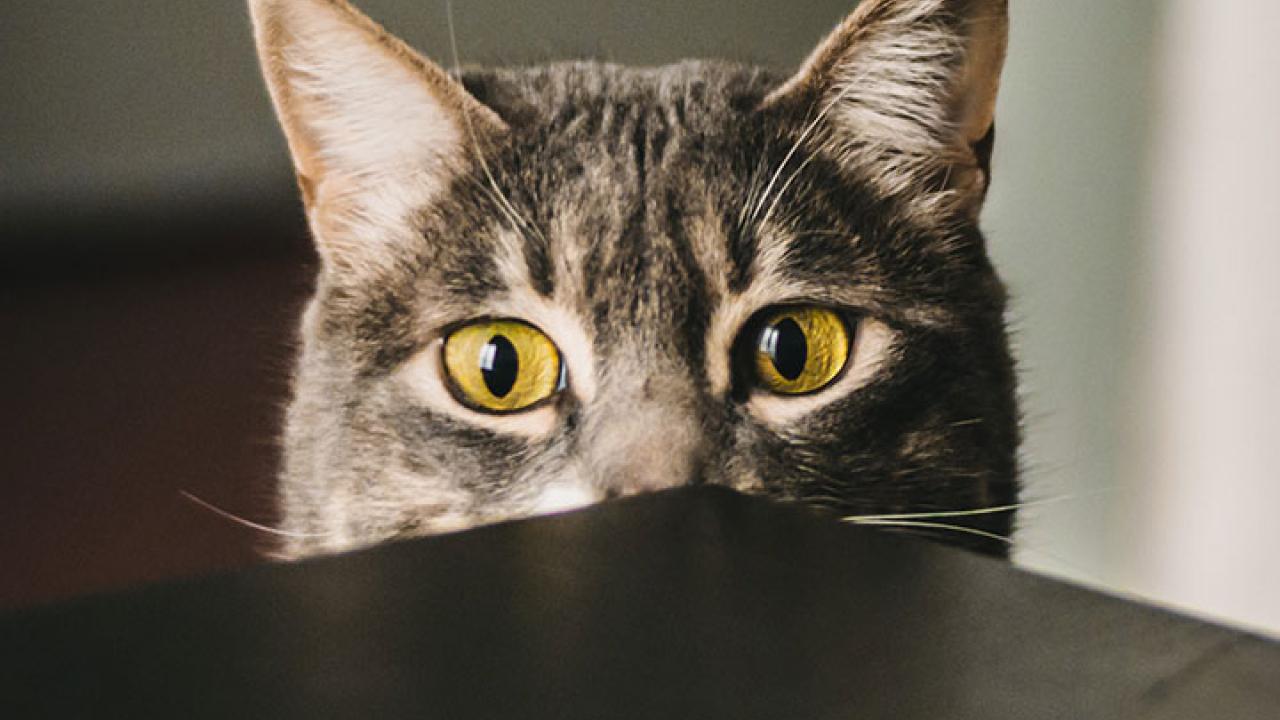fibrosarcoma in cats symptoms
Fibrosarcoma manifests itself as a lump on the skin. Fibrosarcoma in cats can present a number of symptoms.
Fibrosarcoma In Cats Symptoms Diagnosis Treatment Innovet Pet
My 2 year old cat has been diagnosed with fibrosarcoma which is a very aggressive cancer that is associated with vaccines.

. Symptoms can vary depending on the location of the tumour but may include. Being unable to walk and move around Pain around the affected area Presence of lumps Bone fractures Swollen areas of the affected body. The significant causes of cancer in dogs and cats are hereditary environmental trauma infectious diseases foreign bodies orthopedic implants and radiations.
Take note if your pet has trouble climbing up or down stairs if he is reluctant to play or if he walks with an unusual gait. In its early stages a fibrosarcoma usually does not cause any obvious signs or symptoms. Some of the most common symptoms are.
Symptoms of Nasal Fibrosarcoma. This is an increase in circumference a tumor in the skin or subcutaneous tissue. This occurs specially if a tumor presses on surrounding nerves or muscles.
If your cat suddenly begins refusing food and acting uncomfortable around the mouth there can be. Lumps may or may not. Cats with fibrosarcomas will develop a palpable lump or mass under their skin after an injection or vaccination has been administered.
Localised soft tissue swelling. All of these symptoms are common to feline fibrosarcoma cases. This may or may not increase in size.
The diagnosis of a vaccine-associated sarcoma necessitates a biopsy Fibrosarcoma is a locally aggressive cancer of the soft tissues typically. With time if they spread to the lungs and other parts of the body they can cause breathing difficulty anorexia and weight loss. They are most commonly associated with the rabies vaccine.
Cats with oral fibrosarcomas may have difficulty eating and swallowing bad breath and drool. Fibrosarcoma in cats can present a number of symptoms. Life expectancy of fibrosarcoma in cats thankfully in most cases cats who have been diagnosed with fibrosarcoma have a positive outlook.
Causes of fibrosarcoma in cats. Download PDF of this Fibrosarcoma in Cats article Visit the Oncology Service website Vaccine associated fibrosarcomas are tumors that arise at sites where cats have been vaccinated. Gender appears to play some role with male cats being seen for gingival tumors more often that female cats.
Fibrosarcomas feel rough and knotty they can hardly be moved. They are slightly more prevalent in male cats than in female cats and the cause of this is unknown as well. Eventually as the cancer progresses cats with fibrosarcomas will develop these symptoms.
1 This lump can appear within a couple of days months or even years after the injection and be locally aggressive but fibrosarcomas are slow to. Fibrosarcomas are generally more common in dogs than cats although they can occur in cats of any age and breed. They grow quite quickly and if left untreated can break open.
If left untreated these masses can become ulcerated and infected. For example tumors in the gastrointestinal tract may cause vomiting diarrhea or weight loss. This may be firm poorly circumscribed irregular and measure between 1-15cm.
The lump is initially very small and is usually first observed when the cat is being stroked. Pain around the affected area. The symptoms of histiocytic sarcoma will vary depending on the tumors location but nonspecific symptoms such as lethargy weakness lack of appetite and weight loss are common.
Be aware of any changes to your pets mobility. Symptoms can vary depending on the location of the tumour but may include. Fibrosarcoma in Cats How we can help Call 530-752-1393 to schedule an appointment with the Oncology Service.
Causes of fibrosarcoma in cats Image credit. Symptoms of fibrosarcoma are similar to those of many other conditions. Lump under the skin at the site of a vaccination.
They would have to cut her from one end to the other and from top to bottom. Cats with oral fibrosarcomas may have difficulty eating and swallowing bad breath and drool. A nasal fibrosarcoma will present some or all of a wide variety of symptoms.
Often the first sign of feline fibrosarcoma is a lump under the skin and might be where they had received their vaccine. In male dogs fibrosarcoma in the muzzle and nasal cavity is more common than in other sites. A lump or swelling.
Some of the most common symptom include. Cats that are afflicted with gingival fibrosarcomas are on average seven and a half years old but these tumors have been seen in cats from the age of six months to fifteen years. Other common symptoms include swelling of the affected area and pain when the area is touched.
I was left with the decision of a very harsh surgery that would remove part of her bone and muscle and leave her in pain for at least 2 weeks. If your cat has a tumor or growth on his legs or abdomen he may have a hard time walking sitting or moving around. Symptoms of soft tissue cancer in cats.
Symptoms of fibrosarcoma in cats. The lump will be firm and attached to the surrounding area and it will be hard to feel the edges. If you see it in your pet take them to a veterinarian to get a proper diagnosis.
Symptoms of Fibrosarcoma. Localised soft tissue swelling. However over time the following symptoms may arise.
Pain around the affected area. It is important to note that things like weight loss could also be symptomatic of other issues. This may be firm poorly circumscribed irregular and measure between 1-15cm.
Pain swelling or an unusual lump arent necessarily a sign of. Ulceration may develop in advanced cases. Symptoms of fibrosarcoma in cats.
Up to 10 cash back Fibrosarcoma Symptoms The most common and apparent symptom of fibrosarcoma in cats and dogs is a lump which at times may be accompanied by ulceration and bleeding. Middle-aged and older-aged dogs are more susceptible to fibrosarcoma than young dogs. A weakened immune system and weight loss in your felines are other symptoms of this disease.
Symptoms of fibrosarcoma in cats Feline fibrosarcoma can occur at any age but it is most common in senior and middle-aged cats. Suspected Fibrosarcoma in Your Cat. Inability to walk and move.
Lumps may or may not be painful. Some of the most common symptoms are. Inability to walk and move.
They most often affect the skin. Yelena Shander Getty Images The exact cause of. Swollen areas of the affected body.
Swollen areas of the affected body.

Managing Fibrosarcoma In Cats And Dogs Mommy S Memorandum

Fibrosarcoma Bone Cancer In Cats Symptoms Causes Treatments Cattime

Fibrosarcoma In Cats Causes Symptoms And Treatment

Tumor Related To Vaccinations In Cats Petmd

Fibrosarcoma In Cats Causes Symptoms And Treatment

Fibrosarcoma Bone Cancer In Cats Symptoms Causes Treatments Cattime

Feline Injection Site Sarcomas The Veterinary Nurse
/GettyImages-11673268481-ff230807a7e04e2db8e38e148edb19a5.jpg)
How To Treat Fibrosarcomas In Cats

Fibrosarcoma In Cats Causes Symptoms And Treatment

Post Vaccination Sarcoma In Cats Vca Animal Hospitals

Fibrosarcoma In Cats Animal Health Topics School Of Veterinary Medicine

Cat Injection Site Sarcoma The Risks Treatment Prognosis Of This Deadly Tumor Our Pet S Health

The 3 Most Common Cancers In Cats


